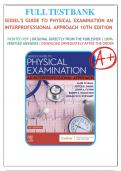FULL TEST BANK
SEIDEL'S GUIDE TO PHYSICAL EXAMINATION AN
INTERPROFESSIONAL APPROACH 10TH EDITION
PRINTED PDF | ORIGINAL DIRECTLY FROM THE PUBLISHER | 100%
VERIFIED ANSWERS | DOWNLOAD IMMEDIATELY AFTER THE ORDER
,Table of content
Chapter 1. Cultural Competency
Chapter 2. The History and Interviewing Process
Chapter 3. Examination Techniques and Equipment
Chapter 4. Taking the Next Steps: Clinical Reasoning
Chapter 5. The Health Record
Chapter 6. Vital Signs and Pain Assessment
Chapter 7. Mental Status
Chapter 8. Growth and Nutrition
Chapter 9. Skin, Hair, and Nails
Chapter 10. Lymphatic System
Chapter 11. Head and Neck
Chapter 12. Eyes
Chapter 13. Ears, Nose, and Throat
Chapter 14. Chest and Lungs
Chapter 15. Heart
Chapter 16. Blood Vessels
Chapter 17. Breasts and Axillae
Chapter 18. Abdomen
Chapter 19. Female Genitalia
Chapter 20. Male Genitalia
Chapter 21. Anus, Rectum, and Prostate
Chapter 22. Musculoskeletal System
Chapter 23. Neurologic System
Chapter 24. Putting It All Together
Chapter 25. Sports Participation Evaluation
Chapter 26. Emergency or Life-Threatening Situations
,Chapter 01: Cultural Competency
Ball: Seidel’s Guide To Physical Examination, 10th Edition
MULTIPLE CHOICE
1. Which Statement Is True Regarding The Relationship Of Physical Characteristics And Culture?
a. Physical Characteristics Should Be Used To Identify Members Of Cultural Groups.
b. There Is A Difference Between Distinguishing Cultural Characteristics
And Distinguishing Physical Characteristics.
c. To Be A Member Of A Specific Culture, An Individual Must Have Certain
Identifiable Physical Characteristics.
d. Gender And Race Are The Two Essential Physical Characteristics Used To
Identify Cultural Groups.
ANSWER: B
Physical Characteristics Are Not Used To Identify Cultural Groups; There Is A Difference
Between The Two, And They Are Considered Separately. Physical Characteristics Should
Not Be Used To Identify Members Of Cultural Groups. To Be A Member Of A Specific
Culture, An Individual Does Not Need To Have Certain Identifiable Physical Characteristics.
You Should Not Confuse Physical Characteristics With Cultural Characteristics. Gender And
Race Are Physical Characteristics, Not Cultural Characteristics, And Are Not Used To
Identify Cultural Groups.
DIF:Cognitive Level: Understanding (Comprehension)
OBJ:Nursing Process—Assessment MSC: Physiologic Integrity: Physiologic Adaptation
2. An Image Of Any Group That Rejects Its Potential For Originality Or Individuality Is
Known As A(N)
a. Acculturation.
b. Norm.
c. Stereotype.
d. Ethnos.
ANSWER: C
A Fixed Image Of Any Group That Rejects Its Potential For Originality Or Individuality Is
The Definition Of Stereotype. Acculturation Is The Process Of Adopting Another Culture’s
Behaviors. A Norm Is A Standard Of Allowable Behavior Within A Group. Ethnos Implies
The Same Race Or Nationality.
DIF:Cognitive Level: Remembering (Knowledge)
OBJ:Nursing Process—Assessment MSC: Physiologic Integrity: Physiologic Adaptation
3. Mr. L Presents To The Clinic With Severe Groin Pain And A History Of Kidney Stones. Mr.
L’s Son Tells You That For Religious Reasons, His Father Wishes To Keep Any Stone That
Is Passed Into The Urine Filter That He Has Been Using. What Is Your Most Appropriate
Response?
a. ―With Your Father’s Permission, We Will Examine The Stone And Request
That It Be Returned To Him.‖
, b. ―The Stone Must Be Sent To The Lab For Examination And Therefore Cannot Be Kept.‖
c. ―We Cannot Let Him Keep His Stone Because It Violates Our Infection Control
Policy.‖ D. ―We Don’t Know Yet If Your Father Has Another Kidney Stone, So We
Must Analyze
This One.‖
ANSWER: A
We Should Be Willing To Modify The Delivery Of Health Care In A Manner That Is
Respectful And In Keeping With The Patient’s Cultural Background. ―With Your Father’s
Permission, We Will Examine The Stone And Request That It Be Returned To Him‖ Is The
Most Appropriate Response.
―The Stone Must Be Sent To The Lab For Examination And Therefore Cannot Be Kept‖
And ―We Don’t Know Yet If Your Father Has Another Kidney Stone, So We Must
Analyze This One‖ Do Not Support The Patient’s Request. ―We Cannot Let Him Keep His
Stone Because It Violates Our Infection Control Policy‖ Does Not Provide A Reason That It
Would Violate An Infection Control Policy.
DIF:Cognitive Level: Analyzing (Analysis)
OBJ:Nursing Process—Assessment MSC: Physiologic Integrity: Physiologic Adaptation
4. The Motivation Of The Healthcare Professional To ―Want To‖ Engage In The
Process Of Becoming Culturally Competent, Not ―Have To,‖ Is Called
a. Cultural Knowledge.
b. Cultural Awareness.
c. Cultural Desire.
d. Cultural Skill.
ANSWER: C
Cultural Encounters Are The Continuous Process Of Interacting With Patients From
Culturally Diverse Backgrounds To Validate, Refine, Or Modify Existing Values, Beliefs,
And Practices About A Cultural Group And To Develop Cultural Desire, Cultural Awareness,
Cultural Skill, And Cultural Knowledge. Cultural Awareness Is Deliberate Self-Examination
And In-Depth Exploration Of One’s Biases, Stereotypes, Prejudices, Assumptions, And ―-
Isms‖ That One Holds About Individuals And Groups Who Are Different From Them.
Cultural Knowledge Is The Process Of Seeking And Obtaining A Sound Educational Base
About Culturally And Ethnically Diverse Groups.Cultural Skill Is The Ability To Collect
Culturally Relevant Data Regarding The Patient’s Presenting Problem, As Well As Accurately
Performing A Culturally Based Physical Assessment In A Culturally Sensitive Manner.
Cultural Desire Is The Motivation Of The Healthcare Professional To Want To Engage In The
Process Of Becoming Culturally Competent, Not Have To.
DIF:Cognitive Level: Understanding (Comprehension)
OBJ:Nursing Process—Assessment MSC: Physiologic Integrity: Physiologic Adaptation
5. Mr. Marks Is A 66-Year-Old Patient Who Presents For A Physical Examination To The
Clinic. Which Question Has The Most Potential For Exploring A Patient’s Cultural
Beliefs Related To A Health Problem?
a. ―How Often Do You Have Medical Examinations?
‖ B. ―What Is Your Age, Race, And Educational Level?
‖
c. ―What Types Of Symptoms Have You Been Having?‖
d. ―Why Do You Think You Are Having These Symptoms?‖
ANSWER: D
―Why Do You Think You Are Having These Symptoms?‖ Is An Open-Ended Question
That Avoids Stereotyping, Is Sensitive And Respectful Toward The Individual, And Allows
For Cultural Data To Be Exchanged. The Other Questions Do Not Explore The Patient’s
Cultural Beliefs About Health Problems.





